
China Maternal and Child Health Development Report (2019)
Preface
The health of women and children is the cornerstone of the health of the whole people, a yardstick for measuring the progress of social civilization, and the basis and prerequisite for the sustainable development of mankind. The Communist Party of China and the Chinese government have always attached great importance to the health of women and children, taking it as an important basic work to protect the rights and interests of women and children and promote the all-round development of women and children. Before the founding of the People’s Republic of China, maternal and child health services were lacking. The vast rural and remote areas lacked medical services and medicines. The maternal mortality rate was as high as 1500/100,000, the infant mortality rate was as high as 200‰, and the average life expectancy was only 35 years. After the founding of the People’s Republic of China, the maternal and child health undertakings took on a new look, and the health of women and children continued to improve. In 2018, the national maternal mortality rate dropped to 18.3 per 100,000, the infant mortality rate dropped to 6.1‰, and the average life expectancy reached 77.0 years, which is better than the mid-to-high level. Income country average.
2019 marks the 70th anniversary of the founding of New China. Looking back over the past 70 years, China's maternal and child health undertaking has gone through an extraordinary journey, and has achieved positive progress and results at different stages of development.
1949-1978 is the growth period. In September 1949, the Chinese People's Political Consultative Conference deliberated and approved the "Common Program", which clearly stated that "pay attention to protecting the health of mothers, infants and children." At the end of October, the Ministry of Health was established, with the Bureau of Maternal and Child Health, and the Department of Maternal and Child Health in the local health departments at all levels, establishing a top-down complete administrative management system for maternal and child health. In 1950, it began to explore the establishment of professional institutions for maternal and child health, strengthen the construction of the talent team, and gradually build a professional service position to protect the health of women and children, laying a foundation for the development of maternal and child health.
1978-2012 is the mature period. Strengthen international cooperation, absorb advanced international concepts and experience, introduce capital and technology, and strengthen policy transformation in light of national conditions. Gradually improve the statistical system of maternal and child health information to provide support for scientific decision-making. Promoting the legalization of maternal and child health, promulgating the "Maternal and Child Health Law of the People’s Republic of China" and its implementation measures, forming a "health-centered, reproductive health protection, combination of health care and clinical practice, oriented to groups, grassroots and The work policy of "prevention first" signifies that the maternal and child health work system has become more mature and finalized. The Chinese government has successively implemented the three-cycle development program for women and children in China. In 2009, it initiated the deepening of the reform of the medical and health system. It has continuously increased its investment in women and children's health, and the fairness and accessibility of women and children's health services have been continuously improved.
Since 2012, it has been a period of leaps and bounds. Since the 18th National Congress of the Communist Party of China, the cause of maternal and child health has ushered in a new historical period. The World Health Organization announced that China has eliminated neonatal tetanus, marking that the quality and accessibility of China's maternal and child health services have reached a new level, and maternal and child health work has shifted from "preserving survival" to "promoting development." General Secretary Xi Jinping proposed that the people's yearning for a better life is our goal, and at the 2016 National Health and Health Conference, he emphasized that we must pay attention to and attach importance to the health of key populations and protect the health of women and children. Maternal and child health work strives to comply with the requirements of the times and the expectations of the people. On the basis of fully ensuring the safety of mothers and children, strengthen the integration of policies and service resources, actively promote the whole process of maternal and child health services, strengthen early childhood development, innovate comprehensive prevention of birth defects, and deeply participate in maternal and child health Global governance has pushed the cause of maternal and child health into a new era.
Over the past 70 years, China has made great efforts to protect the health of women and children. The rights of women and children in China to survival, health, and development have been fully guaranteed, and they have made important contributions to the promotion of sustainable economic and social development. These achievements are due to the fact that China’s maternal and child health undertakings have been advancing closely around the two main lines. The first is to focus on the central task of the Communist Party of China in the various historical periods of the construction, reform and development of the new China, adhere to the promotion of maternal and child health under the guidance of the party's various policies and policies, serve the overall work of the party and the country, and promote the coordinated economic and social development. The second is to focus on the outstanding health problems of women and children in various periods and focus on solutions to promote the continuous improvement of women and children’s health.
Magnificent 70 years, striving for a new era. Today, we released the "Report on the Development of China’s Maternal and Child Health Career (2019)", which aims to provide the public and the international community with a comprehensive introduction to the development of China’s maternal and child health career, guide the whole society to pay more attention to the health of women and children, and promote the realization of the United Nations 2030 Sustainable Development Goals as scheduled . At the same time, summarize achievements and experience, recognize challenges and opportunities, and inspire women and children's health workers across the country, do not forget their original aspirations, keep their mission in mind, reorganize their clothes and set off again, in order to promote the all-round development of women and children, promote the construction of a healthy China, and win the building of a well-off society in an all-round way. Gather the majestic strength.
一、Significant improvement in the health of women and children
(一)Women's life expectancy is gradually increasing
In 2015, the life expectancy of Chinese women was 79.4 years, 8.9 years longer than in 1990 (Figure 1).
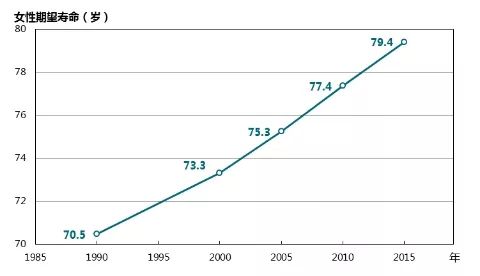
Figure 1 Trends in female life expectancy from 1990 to 2015
(Data source: China Statistical Yearbook)
(二)The maternal mortality rate is steadily declining
In 1990, the national maternal mortality rate was 88.8 per 100,000, and in 2018 it dropped to 18.3 per 100,000, a decrease of 79.4% from 1990 (Figure 2).
The gap between urban and rural areas has narrowed significantly. In 2018, the rural and urban maternal mortality rates were 19.9 per 100,000 and 15.5 per 100,000, respectively, a decrease of 81.2% and 67.2% compared with 1990. In 1990, the ratio of urban to rural maternal mortality was 1:2.2, and in 2018 it dropped to 1:1.3 (Figure 2).
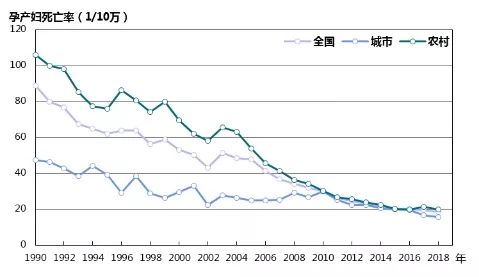
Figure 2 Trends in the national maternal mortality rate from 1990 to 2018
(Data source: National Maternal and Child Health Monitoring System)
The regional gap continues to narrow. In 2018, the maternal mortality rates in the eastern, central and western regions were 10.9 per 100,000, 20.0? per 100,000, and 25.2 per 100,000, respectively, which were down by 61.9%, 70.5%, and 81.2% compared with 1996. The maternal mortality rate in the western region was 4.7 times that of the eastern region in 1996, and dropped to 2.3 times in 2018 (Figure 3).

Figure 3 The trend of maternal mortality in different regions from 1996 to 2018
(Data source: National Maternal and Child Health Monitoring System)
Maternal deaths caused by obstetric hemorrhage have been drastically reduced. In 2000, the national mortality rate of obstetric hemorrhage was 20.8 per 100,000. In 2017, it dropped to 5.7 per 100,000, a decline of 72.6%, contributing 45.2% of the national maternal mortality rate. In particular, the decline in rural areas was even more pronounced, with a decrease of 80.9% between 2000 and 2017, contributing 52.4% to the decline in maternal mortality in rural areas.
The United Nations Millennium Development Goal requires that by 2015, the maternal mortality rate should be reduced by three quarters compared to 1990. China achieved it ahead of schedule in 2014. It is one of the few countries in the world that achieves this goal.
(三)Child mortality rate has dropped significantly
The neonatal mortality rate, infant mortality rate and mortality rate of children under 5 years of age decreased from 33.1‰, 50.2‰, and 61.0‰ in 1991 to 3.9‰, 6.1‰, and 8.4‰ in 2018, respectively, a decrease of 88.2% and 87.8%. % And 86.2% (Figure 4).
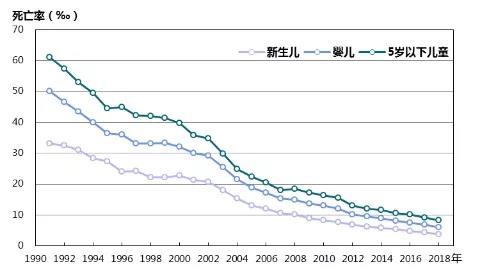
Figure 4 Trends in the under-five mortality rate, infant mortality rate, and neonatal mortality rate from 1991 to 2018
(Data source: National Maternal and Child Health Monitoring System)
The gap between urban and rural areas has narrowed significantly. In 2018, the mortality rate of children under 5 in rural and urban areas was 10.2‰ and 4.4‰, respectively, which were 85.7% and 78.9% lower than in 1991. In 1991, the ratio of the mortality rate of children under 5 in urban and rural areas was 1:3.4, and in 2018 it was reduced to 1:2.3 (Figure 5).
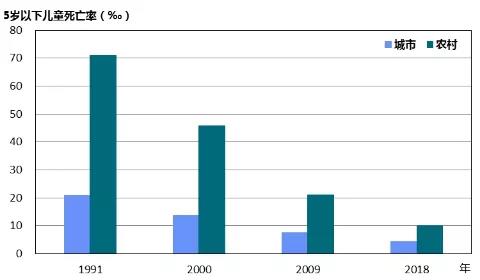
Figure 5: Comparison of the mortality rate of children under 5 in urban and rural areas across the country from 1991 to 2018
(Data source: National Maternal and Child Health Monitoring System)
The regional gap continues to narrow. In 2018, the mortality rate of children under 5 in the eastern, central and western regions was 4.2‰, 7.2‰, and 12.7‰, respectively, which were 87.5%, 89.1%, and 87.3% lower than in 1991. The difference in mortality among children under 5 in the east and west has shrunk from 66.5‰ in 1991 to 8.5‰ in 2018 (Figure 6).
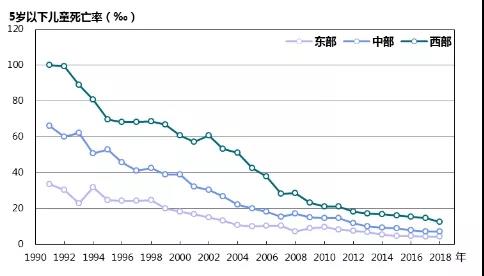
Figure 6 Trends in the under-five mortality rate in different regions from 1991 to 2018
(Data source: National Maternal and Child Health Monitoring System)
The mortality rate of children under 5 years of age from major diseases has dropped significantly. In 2017, the top 5 causes of death for children under 5 years of age were premature birth or low birth weight, pneumonia, birth asphyxia, congenital heart disease and accidental asphyxia, accounting for 55.7% of all deaths, a decrease of 79.1% compared to 2000 .
The United Nations Millennium Development Goals require that by 2015, the mortality rate of children under 5 years old should be reduced by two-thirds compared to 1990. China achieved this goal eight years ahead of schedule in 2007.
The decline in the mortality rate of children under 5 years of age has made an important contribution to the increase in life expectancy per capita in our country. According to estimates, of the 4.9 years of life expectancy increase in China between 2000 and 2015, 23.5% was attributed to the decline in the mortality rate of children under 5 years of age.
(四)Continuous improvement of children's growth and development
The stunting rate of children under 5 years of age in China continues to decline. In 2013, the stunting rate of children under the age of 5 in China was 8.1%, a decrease of 75.5% compared with 33.1% in 1990.
The decline in rural areas is greater than that in cities, and the gap between urban and rural areas is gradually narrowing. From 1990 to 2013, the stunting rate of children under 5 in urban areas dropped from 11.4% to 4.3%, and in rural areas from 40.3% to 11.2%, the stunting rates in urban and rural areas dropped by 62.3% and 72.2%, respectively (Figure 7).
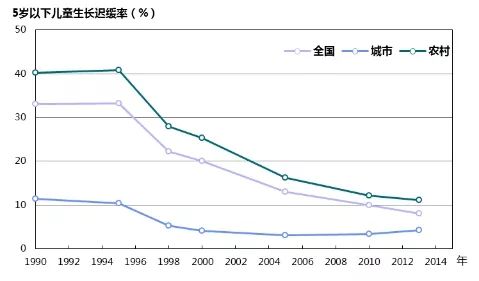
Figure 7 Trends in the growth rate of children under 5 years of age in China from 1990 to 2013
(Data source: Nutrition and health status monitoring of Chinese residents)
(五)Obvious results in prevention and treatment of birth defects
Child deaths due to birth defects have dropped significantly. Compared with 2007, in 2017, birth defects caused the mortality rate of children under 5 to drop from 3.5‰ to 1.6‰, contributing more than 17% of the national mortality rate of children under 5 years of age, and playing a role in improving the quality of the birth population and the health of children. Played an important role.
The incidence of some major birth defects has shown a downward trend. The national incidence of neural tube defects in the perinatal period dropped from 274,000 per 10,000 in 1987 to 15,000 per 10,000 in 2017, a decrease of 94.5%, from the first place among the 23 types of birth defects monitored during the perinatal period to the first. 12 bits. The prevention and treatment of thalassemia has achieved remarkable results. The incidence of fetal edema syndrome (severe alpha thalassaemia) in Guangdong and Guangxi has dropped from 217,000 per 10,000 and 446,000 per 10,000 in 2006 to 193,000 and 31,500 per 10,000 in 2017, a decrease of 91% respectively. % And 93%.
二、Maternal and child health services continue to improve
Adhere to women and children as the center, strive to provide fair, accessible and systematic and continuous maternal and child health services for all women and children, continuously improve policy systems and service chains, and gradually realize full health services and guarantees from the fetus to the end of life.
(一)Maternity health
1.?Provide a full range of health care services during pregnancy
Popularize prenatal checkups and enrich service content. Open pre-pregnancy consultation clinics, provide fertility assessment and pregnancy guidance, and educate the masses to establish a scientific concept of pregnancy. Encourage midwifery institutions to open maternity schools, strengthen health education and health promotion for pregnant women and their families, popularize knowledge about pregnancy and health, and improve pregnant women’s health literacy and skills. With the "Mother and Child Health Handbook" as a carrier, five prenatal checkups are carried out for pregnant women free of charge, and the whole process of reproductive health care services are promoted. Comprehensively implement the classification management of pregnancy risks and the project management of high-risk pregnant and lying-in women, and realize the advancement of the defense line of pregnant and lying-in women's risk management. The national prenatal examination rate has steadily increased, from 83.7% in 1996 to 96.6% in 2018, and in rural areas from 80.6% to 95.8% (Figure 8).
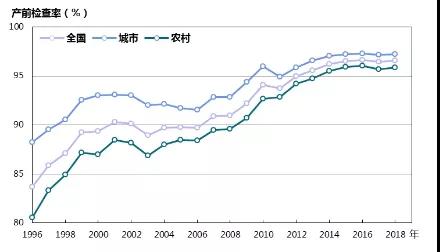
The change trend of prenatal inspection rate from 1996 to 2018
(Data source: National Maternal and Child Health Annual Report System)
Make every effort to prevent mother-to-child transmission of AIDS, syphilis, and hepatitis B. Provide free screenings for AIDS, syphilis, and hepatitis B for pregnant women across the country, and provide comprehensive intervention services to prevent mother-to-child transmission for all pregnant women and their children who are found to be infected. In recent years, the rate of maternal AIDS, syphilis and hepatitis B testing has stabilized at over 99%, and the rate of mother-to-child transmission of AIDS has dropped from 34.8% before the intervention to 4.5% in 2018 (Figure 9). The number of reported cases of congenital syphilis has fallen more than 70%, the injection rate of hepatitis B immune globulin for children born to pregnant women with hepatitis B infection reached 99.7%, effectively avoiding and reducing new infections in children.
Explore the development of specialized services such as nutrition and psychology during pregnancy and childbirth, strengthen the management of specialized diseases such as gestational diabetes and hypertension in pregnancy, and ensure the physical and mental health of pregnant women in all aspects.
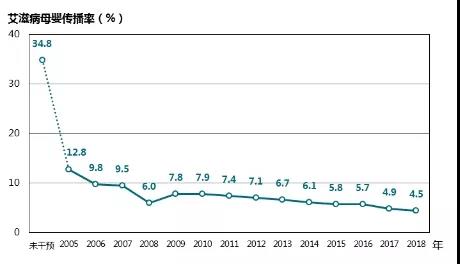
Figure 9 Trends in the rate of mother-to-child transmission of AIDS from 2005 to 2018
(Data source: Management Information System for the Prevention of Mother-to-child Transmission of AIDS, Syphilis and Hepatitis B)
2.Comprehensively promote the universalization of hospital delivery
Continue to increase the hospital delivery rate. In 2000, the pilot project to reduce maternal mortality and eliminate neonatal tetanus was implemented. In 2009, the rural pregnant and lying-in women’s hospital delivery subsidy program was fully implemented. A fixed subsidy was provided to rural pregnant and lying-in women for hospitalized delivery. In some areas, free hospital delivery was achieved, and some provinces also gave it. Subsidies for living and transportation expenses. The nationwide hospital delivery rate has increased significantly, from 60.7% in 1996 to over 99% in the past six years. In particular, the hospital delivery rate in rural areas rose from 51.7% in 1996 to 99.8% in 2018, and the gap between urban and rural areas was significantly reduced, making an important contribution to reducing maternal mortality (Figure 10). The hospital delivery rate in the western region rose from 44.8% in 1996 to 99.7% in 2018, and the regional gap was basically eliminated (Figure 11).

Figure 10 1996-2018 national urban and rural hospital delivery rate and the change trend of maternal mortality rate
(Data source: National Maternal and Child Health Annual Report System, National Maternal and Child Health Monitoring System)

Figure 11 The change trend of hospital delivery rates in different regions from 1996 to 2018
(Data source: National Maternal and Child Health Annual Report System)
The obstetric service capacity has been continuously improved, and the maternal delivery experience has continued to improve. In 2018, there were 26,000 midwifery institutions nationwide, with 180,000 midwives and nearly 210,000 obstetricians. Vigorously promote natural childbirth, encourage midwifery institutions to provide services such as Doula childbirth and childbirth companions, and actively promote childbirth analgesia services. The national cesarean section rate in 2018 was 36.7%.
3.Promote postpartum health services
Strengthen postpartum visits. The state provides free 1-week postpartum visits and 42-day postpartum checkups to all women, carries out postpartum health care guidance and health checkups, and provides guidance on breastfeeding and postpartum contraception. The postpartum visit rate has increased from 80.1% in 1996 to 2018. 93.8% (Figure 12).
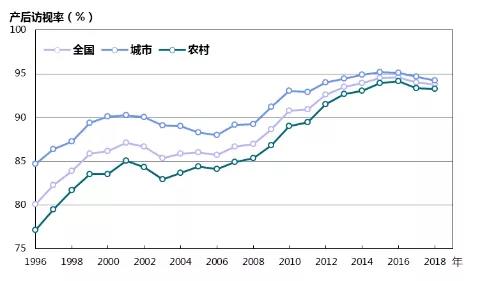
Figure 12 The trend of postpartum visit rate from 1996 to 2018
(Data source: National Maternal and Child Health Annual Report System)
Promote postpartum rehabilitation. Medical institutions at all levels are actively exploring the development of postpartum breast health care, pelvic floor function rehabilitation and other medical care services. Support and encourage society to run medical services, standardize the development of personalized postpartum rehabilitation services, and continue to meet the diverse health service needs of the people.
Strengthen the systemic management of pregnant and lying-in women. A systematic and standardized management system and service model for pregnant and lying-in women have been gradually established, effectively guaranteeing the health of pregnant and lying-in women and newborns. The rate of systematic management of pregnant women continued to increase, from 65.5% in 1996 to 89.9% in 2018 (Figure 13).
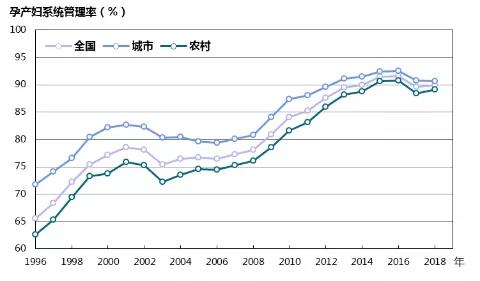
Figure 13 1996-2018 trend of changes in maternal system management rate
(Data source: National Maternal and Child Health Annual Report System)
(二)Child Care
1.Improve children's health management
Strengthen the treatment of critically ill newborns. Strengthen the close cooperation between the hospital's obstetricians and pediatricians before, during and after delivery, and require a professional trained in neonatal resuscitation to be present at each delivery site. Carry out project management for premature babies, promote the development of kangaroo-style care for premature babies, improve the quality of life of premature babies, promote appropriate technologies such as early basic health care for newborns and newborn resuscitation, and improve the level of newborn health care. From 2003 to 2014, the national infant mortality rate of asphyxia, the mortality rate of newborns within 24 hours of asphyxia, and the rate of mortality within 7 days of asphyxia of birth decreased by 75.1%, 81.3%, and 76.9%, respectively.
Strengthen newborn visits. Guide parents to do a good job in newborn feeding, nursing and disease prevention, early detection of abnormalities and diseases, timely treatment and treatment, and the rate of newborn visits has steadily increased, from 81.4% in 1996 to 93.7% in 2018, and the gap between urban and rural areas has been narrowing. (Figure 14).
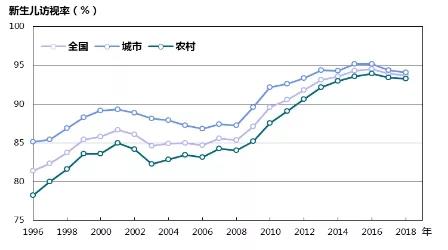
Figure 14 1996-2018 trend of urban and rural newborn visit rate
(Data source: National Maternal and Child Health Annual Report System)
Strengthen the systematic management of children under 7 years of age. Combining the characteristics of different developmental stages, we provide 4 free health check-ups for children under 1 year old, 2 free health check-ups for children aged 2 and 3 years old, and 1 free health check-up every year for children aged 4-6, focusing on physical fitness Examination, growth and mental development assessment, hearing and vision screening, and provide parents with breastfeeding, supplementary food supplementation, accidental injury prevention, psychological and behavioral development, oral health care, common disease prevention and other health guidance. The national systematic management rate for children under 3 years old and the health management rate for children under 7 years old have increased steadily, from 61.4% and 62.7% in 1996 to 91.2% and 92.7% in 2018, respectively. The urban-rural gap has been narrowing (Figure 15 and Figure 16). ).

Figure 15 1996-2018 trend of changes in the system management rate of children under 3 in urban and rural areas
(Data source: National Maternal and Child Health Annual Report System)
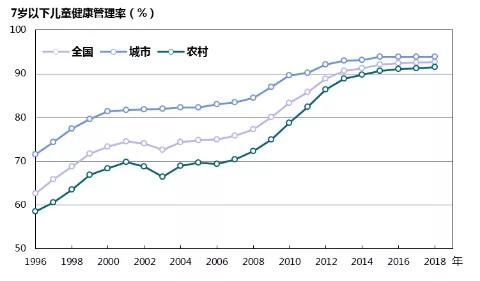
Figure 16 1996-2018 trends in the health management rate of children under 7 in urban and rural areas
(Data source: National Maternal and Child Health Annual Report System)
2.Strengthen the prevention and treatment of childhood diseases
Standardize the development of immunization services. Implement the nationwide immunization program for children, and continuously expand the types of vaccines in the national immunization program, from the initial prevention of 6 diseases to the prevention of 15 diseases. Primary-level medical and health institutions provide free vaccination services to children in their jurisdictions. In 2018, the vaccination rate of the national immunization program with the township as a unit was maintained at more than 95%. Major infectious diseases in children have been effectively controlled. China has gradually eliminated smallpox and achieved the goal of being polio-free. After 2006, there have been no reports of diphtheria cases for 13 consecutive years. The carrying rate of hepatitis B virus surface antigen in children under 5 years of age dropped from 9.7% in 1992 to 0.3% in 2014, a decrease of 96.7%; the incidence of measles in 2018 dropped to less than 0.28 per 100,000, and the number of cases was less than 4,000; 2018 There were only 104 cases of meningococcal infections nationwide each year, all of which fell to the lowest level in history.
Scientifically prevent and control key children's diseases. Incorporate early screening of children's psychological and behavioral development problems into the national basic public health services to achieve early screening of vision, hearing, physical, intellectual disabilities and autism. Strengthen the prevention and control of myopia in children, guide primary medical and health institutions to carry out eye care services, conduct free annual vision examinations and establish visual health files for children under 7 years of age, conduct knowledge about myopia prevention and control, and improve the awareness of myopia prevention and control in the whole society. Strengthen the prevention and treatment of children's oral diseases, and carry out comprehensive interventions for children's oral health education, health examinations, topical fluoride, and pit and fissure closure across the country. Strengthen the management of childhood leukemia treatment, carry out designated treatment for children with leukemia, simplify and optimize the settlement and reimbursement process, and implement "one-stop" settlement services such as basic medical insurance, critical illness insurance, and medical assistance, which have effectively reduced the burden on families of children with leukemia.
Vigorously protect children's medication. Since 2017, a consultation linkage mechanism has been established to ensure the supply of drugs for shortages in the country, which has solved the problem of shortage of supply of drugs for 66 children. Establish a "priority review fast track". Children's drugs that are specifically supported by new drugs and are in urgent clinical need will be included in the fast track after review. Since 2018, 22 varieties (dosage forms) that are urgently needed for children's clinical use have been included in the list of essential medicines. The central government has invested more than 300 million yuan to organize more than 30 units to jointly carry out research on children's drug varieties and key technology research and development projects, and effectively guarantee the prevention and treatment of children's key diseases.
3.Improve Child Nutrition
Implement infant and young child feeding strategies. Strengthen the guidance of scientific feeding of infants and young children, and strengthen the knowledge and skills of scientific feeding of infants and young children by medical staff and child caregivers. Innovate the management of baby-friendly hospitals, promote medical institutions to carry out mother-and-baby sharing and scientific breastfeeding guidance. There are 7,036 baby-friendly hospitals nationwide. The 10 national departments are accelerating the construction of public places and employers’ maternal and child facilities. By the end of 2018, the allocation rate of public places that should be equipped with maternal and child facilities reached over 80%. Strengthen breastfeeding publicity, promote, promote and support breastfeeding in the whole society.
Improve the nutritional status of children in poverty-stricken areas. In 2012, the implementation of the nutritional improvement project for children in poverty-stricken areas was launched to provide free 1 packet of complementary food and nutritional supplements for infants and young children aged 6-24 months in contiguous areas with special difficulties in the country, and strengthen scientific feeding guidance and health education for parents. By the end of 2018, it had covered 715 national-level poverty-stricken counties, benefiting 7.22 million children in total. The average anemia rate and growth retardation rate of infants and young children from 6 to 24 months in 2017 in the monitored areas decreased by 46.5% and 36.6% respectively compared with 2012, which effectively improved the nutritional status of children in poverty-stricken areas.
Strengthen the monitoring and prevention of childhood obesity. Carry out the monitoring and evaluation of children's growth and development, strengthen personalized nutrition guidance, guide children in a scientific and balanced diet, strengthen physical exercise, and prevent and reduce childhood obesity. Implement comprehensive intervention projects on child nutrition, research and develop appropriate technologies for child obesity prevention and intervention.
Improve food safety standards for children. The Chinese government attaches great importance to food safety for children. Formulated and issued national standards such as "Infant Formula", "Follow-up and Young Children Formula", "General Rules of Special Medical Purpose Infant Formula", "Infant Cereal Supplementary Foods", "Canned Supplementary Foods for Infants and Young Children", "Complementary Food Nutrition Supplements" and other national standards . In the basic standards such as "National Food Safety Standard? Standards for the Use of Nutritional Enhancers", "National Food Safety Standards? General Principles for Nutrition Labeling of Prepackaged Foods" and other basic standards, the growth and development, food safety and nutritional characteristics of special populations such as children are fully considered to ensure the protection of infants. Food safety for young children.
4.Promote Early Childhood Development
Scientifically advance the work of early childhood development, standardize the construction of early childhood development demonstration bases, and establish 50 national early childhood development demonstration bases across the country. Organize the development of relevant teaching materials and popular science textbooks, strengthen the training of teachers, improve work norms and standards, introduce international child development monitoring service packages, and develop the Chinese child development screening scale. Actively promote the equalization of early childhood development, promote early childhood development services to enter the countryside, communities, and families, and promote the overall development of children's physical, psychological, cognitive, emotional and social adaptability.
(三)Women's Health
1.Comprehensive Protection Of Women's Health
Carry out prevention and treatment of common diseases among women. The screening of common diseases among women has been continuously strengthened, and the screening rate for common diseases among women has gradually increased, reaching 75.5% in 2018. Strengthen the publicity of women’s common disease prevention and control knowledge, enhance women’s self-care ability, and establish the awareness that individuals are the first responsible person for health. Do a good job of follow-up treatment for common diseases of women, improve the linkage mechanism of screening, diagnosis and treatment, and protect women's health.
Promote the prevention and treatment of major diseases of women. In response to the main health problems of women in different historical periods, we have concentrated our efforts to carry out general surveys and treatments, and gradually reduced the impact of diseases such as uterine prolapse and urinary fistula on women’s health. Implement cervical cancer and breast cancer screening programs for rural women, and continuously increase the rate of early diagnosis and treatment. From 2009 to 2018, the coverage was expanded from 200 counties (cities, districts) to more than 1,700, providing a total of 85 million women with cervical cervix Cancer screening, 20 million women provide breast cancer screening. Bring breast cancer and cervical cancer into the scope of national treatment for serious diseases, and continuously improve treatment guarantees.
Strengthen occupational health protection for female employees. Implement the State Council’s "Special Provisions on Labor Protection for Female Employees", promote employers to strengthen labor protection for female employees during pregnancy, childbirth, breastfeeding and other special menstrual periods, clarify the scope of female employees’ taboos to engage in labor, improve labor safety and health conditions for female employees, and promote female employees. Training on labor safety and health knowledge for employees.
2.Promote Adolescence And Menopause Care
Explore the development of adolescent health care. Incorporate health education into the national education system, and vigorously carry out knowledge publicity and education on reproductive health, AIDS prevention and control in schools and communities, and improve the sexual and reproductive health of young people. Encourage young people to eat reasonably and control their weight, actively participate in sports and social practice, pay attention to the mental health of young people, and promote young people to form a positive and healthy physical and mental state. Encourage women and children health care institutions at all levels to set up adolescent health care clinics, carry out adolescent health care services and health consultation and guidance. In 2018, the total number of outpatient visits reached 1.33 million.
Promote menopausal health care. To meet the health needs of menopausal women, carry out popular health education and provide health consultation and guidance. Encourage women and children health care institutions at all levels to set up menopausal clinics, promote the construction of menopausal health care specialists, provide menopausal women with health screening assessment, nutrition, psychology, exercise counseling and guidance, hormone determination and osteoporosis diagnosis and treatment, pelvic floor function assessment and rehabilitation, and individual Health education and other services have continuously improved the quality of life of menopausal women. In 2018, the total number of outpatient visits reached 2.32 million.
(四)Reproductive Health
1.Respect And Protect Women's Reproductive Health Rights
Vigorously promote the equalization of contraception and birth control services. Incorporate the distribution of contraceptives and basic contraceptive operations into the national basic public health services, and provide them free of charge to all people of childbearing age. In 2017, governments at all levels invested a total of 460 million yuan and provided 230 million people with free contraceptives. Increase reproductive health knowledge publicity and health education, extensively carry out consultation and guidance, encourage contraceptives to enter the community, set up automatic dispensers, and improve the accessibility of contraceptive and birth control services.
Promote the transformation of family planning technical services. Provide a wide range of basic contraception and birth control services and birth-related services. In 2017, more than 70 million related consultations, guidance, and follow-up services were carried out nationwide, and 19.04 million family planning technical services were provided.
Promote the integration of reproductive health care into women’s health management. Focus on women's health, improve policies and optimize processes. Actively promote postpartum and post-abortion contraceptive services, and provide systematic, standardized and warm reproductive health services. Improve the awareness and ability of reproductive health of people of childbearing age, maintain suitable birth spacing, and reduce unwanted pregnancies.
2.Standardize infertility diagnosis and treatment services
The demand for infertility diagnosis and treatment services is gradually being met. In 1983, the first artificial insemination with frozen semen was successful in mainland China, and the first test-tube baby was born in 1988. Since then, the rapid development of various assisted reproductive technologies, the gradual improvement of technical levels, and the continuous enhancement of service capabilities have brought the gospel to tens of thousands of infertile couples and promoted family happiness and social harmony. As of the end of 2018, China had 497 medical institutions approved to carry out human assisted reproductive technology, and 26 medical institutions approved to set up human sperm banks. In recent years, the total number of cycles in various types of human assisted reproduction technologies has exceeded 1 million, and the number of births has exceeded 300,000.
(五)Comprehensive Prevention And Treatment Of Birth Defects
1.Comprehensively Promote Primary Prevention
Strengthen health education and publicity on the prevention of birth defects, and actively promote pre-marital health services. 24 provinces have implemented free pre-marital examinations. In 2018, 10.2 million newlyweds received pre-marital medical examinations, and the pre-marital examination rate reached 61.1%. Implemented the national pre-pregnancy health checkup project, and provided free health education, health check, risk assessment, counseling and guidance for 19 pre-pregnancy pre-pregnancy services for rural couples planning to become pregnant. From 2010 to 2018, a total of 83.49 million planned pregnancy couples were provided with free check-ups . The project of supplementing folic acid to prevent neural tube defects was implemented. From 2009 to 2018, nearly 102 million women giving birth were given free folic acid supplements.
2.Continuously Strengthen Secondary Prevention
Gradually expand the coverage of prenatal screening and prenatal diagnosis, strengthen personnel training and network construction, continue to promote the management and promotion of appropriate technologies such as genetic counseling, medical imaging, molecular biology, cytogenetics and molecular genetics, and prenatal serology for Down syndrome The screening rate reached 61.1%. As of the end of 2018, there were more than 1,000 prenatal screening institutions nationwide, 371 medical institutions that have been approved to provide prenatal diagnosis technical services, and 30 provinces across the country have carried out prenatal screening and prenatal diagnosis. The service is fair and accessible. Accessibility continues to improve. Strengthening the prevention and control of thalassemia, as of 2018, provided free screening for 1.645 million couples in 10 southern provinces, effectively reducing the births of children with thalassemia major.
3.Gradually Implement The Three-Level Prevention
Steadily expand the coverage of neonatal disease screening, focusing on screening for phenylketonuria, congenital hypothyroidism and hearing impairment. In 2017, the national neonatal genetic and metabolic disease screening rate reached 97.5%. In 2018, newborn congenital heart disease screening was launched. Strengthen the protection of birth defects, and promote the inclusion of five birth defect diseases, including congenital heart disease, hemophilia, cleft lip and palate, hypospadias, and phenylketonuria, into the scope of major illness protection. Implement congenital structural malformations and genetic and metabolic diseases rescue projects, and provide medical expenses subsidies for children with 72 types of structural malformations in 6 categories and multiple genetic and metabolic diseases.
三、Comprehensive development of maternal and child health
(一)Continuously improve the legal system and policy system for maternal and child health
The first is to strengthen the legal system for maternal and child health. Article 49 of the Constitution of the People’s Republic of China stipulates that “marriage, family, mothers and children shall be protected by the state”. The Maternal and Child Health Law, the Population and Family Planning Law, the Law on the Protection of Women’s Rights and Interests, and the Law on the Protection of Minors have been promulgated one after another, and the protection of women and children’s health rights has become the will of the state. The State Council formulates regulations on the implementation of the Maternal and Child Health Care Law, Family Planning Technical Service Management Regulations, and Special Provisions on Labor Protection for Female Employees, etc., to refine policies and measures to promote support from government departments at all levels and the entire society to ensure the health of women and children.
The second is to continue to improve the maternal and child health policy system. Incorporating women’s and children’s health into important policies and plans of the Party and the state, in the "Outline for the Development of Chinese Women", "Outline for the Development of Chinese Children", "Outline of the Thirteenth Five-Year Plan for National Economic and Social Development", and "Outline of the "Healthy China 2030" Plan In important documents such as the “Decision of the Central Committee of the Communist Party of China and the State Council on Winning the Tough Fight Against Poverty”, clear goals, requirements and policy measures are put forward, and core indicators and key policy measures for maternal and child health are included in the evaluation of government goals at all levels to promote the implementation of various tasks. Formulate and improve relevant regulations and standards for maternal and child health, strengthen industry-wide management, and gradually form a systematic and complete maternal and child health policy system.
(二)Continue to strengthen the construction of a maternal and child health service network with Chinese characteristics
Continue to strengthen the construction of urban and rural maternal and child health service networks, and gradually form a combination of health care and clinical care with maternal and child health institutions as the core, primary medical and health institutions as the foundation, and large and medium-sized general hospitals and specialized hospitals and related scientific research and teaching institutions as the support, with Chinese characteristics Maternal and child health service network. As of 2018, there are 3,080 maternity and child health care institutions, 807 maternity hospitals, and 129 children’s hospitals, with nearly 640,000 employees, 400 million outpatient visits, 13.79 million hospitalizations, 338,000 beds, and various types of medical care. The number of beds in obstetrics and gynecology and pediatrics in institutions continues to increase. In the fields of obstetrics and gynecology diseases and children's health, 5 national clinical medical research centers and 15 key laboratories at the committee level will be established. Since the 18th National Congress of the Communist Party of China, China has made great efforts to promote supply-side structural reforms, and the maternal and child health service system has ushered in a leap-forward development.
One is to promote the optimization and integration of technical service resources. Strengthen the integration of maternal and child health and family planning technical service resources, and build a maternal and child health service system that shares resources, complements each other's advantages, operates efficiently, and satisfies the masses.
The second is to strengthen the standardized construction and standardized management of maternal and child health care institutions. In accordance with the principle of combining health care with clinical practice, the whole life cycle and the concept of tertiary prevention, with primary and secondary prevention as the focus, the service process is optimized, the service content is integrated, and maternal and child health care institutions at all levels are encouraged to take population health as the center. The Ministry of Maternity and Child Health, the Ministry of Children’s Health, the Ministry of Women’s Health, and the Ministry of Family Planning Technical Services provide women and children with services and management throughout the life cycle and the whole process of health. Carry out the evaluation of maternal and child health care hospitals, strengthen the construction of the discipline system and the staff team, enrich the service content, activate the vitality of the organization, and improve the service efficiency.
The third is to increase investment in the construction of maternal and child health care institutions. From 2016 to 2018, the Chinese government invested 8.48 billion yuan to support the construction of 561 maternal and child health care institutions across the country. Governments at all levels have strengthened funding support, and the infrastructure construction of maternal and child health care institutions has been significantly improved.
The fourth is to actively promote the sinking of high-quality resources for maternal and child health. Through the establishment of maternal and child health service consortiums, telemedicine, and counterpart support, we will promote the sinking of high-quality maternal and child health service resources and improve the service capabilities of primary medical and health institutions. Encourage vertical alliances between medical institutions at all levels to form a working mechanism of division of labor and collaboration, and upper and lower linkages, to improve the accessibility of high-quality medical resources.
The fifth is to promote "Internet + maternal and child health" services. Actively apply Internet technology and big data platforms to improve information collection, analysis and application capabilities. Improve self-service equipment and convenient service facilities, provide a wide range of convenient services such as online appointment appointments, waiting reminders, payment payment, and diagnosis and treatment report inquiries, comprehensively carry out appointment appointment services, promote appointments for in-patient delivery, guide the masses to orderly see a doctor, and effectively improve the experience of the masses. .
(3) Increase investment in protection of women and children's health
Overall consideration of the country’s economic and social development status and women’s and children’s health needs, adhere to the policy of focusing on prevention and combining prevention and treatment, adhere to the principle of public welfare for women and children’s health, gradually increase investment and protection for women’s and children’s health, and establish a relatively complete investment guarantee policy and mechanism .
One is to establish a basic public health service system. Since 2009, the national basic public health service project has been implemented, and the per capita subsidy has been gradually increased, from 15 yuan per capita initially to 55 yuan per capita in 2018. Free provision for all residents including the establishment of health records, health education, vaccination, and maternal health There are 55 basic public health services in 14 categories, including management and health management of children aged 0-6. In 2018, the central government invested 41.55 billion yuan, and local governments at all levels arranged subsidies in full, which effectively guaranteed the implementation of the project. It is an important institutional arrangement for the Chinese government to ensure the health of the people.
The second is to establish a policy support system to solve major health problems of women and children. In response to major issues affecting women and children's health at different stages of development, a major public health project for women and children has been established to increase human, material and financial guarantees, continue to increase intervention efforts, and promote the resolution of related issues. Since 2000, it has successively established and implemented the project to reduce maternal mortality and eliminate neonatal tetanus, the rural maternal hospital delivery subsidy project, the prevention of mother-to-child transmission of AIDS, syphilis and hepatitis B, the "two cancers" inspection project for rural women, and the supplementation of folic acid to prevent nerves. Major projects such as the management defect project, the free pre-pregnancy health check-up project, the child nutrition improvement project in poverty-stricken areas, the newborn disease screening project, the thalassemia prevention and control project, etc., are useful for reducing maternal mortality, preventing major diseases of women and children, and increasing the birth population. Quality played an important role.
The third is to establish a medical security system covering the entire population. Basically, a medical insurance system covering the entire population has been established, forming a "safety net" for residents to ensure medical care. China's basic medical insurance participation rate has stabilized at more than 98%, and the number of basic medical insurance participants has exceeded 1.35 billion. Governments at all levels have increased the basic medical insurance subsidies for urban and rural residents year by year, and the proportion of residents paid has been declining year by year.
The fourth is to provide scientific and technological support for the development of maternal and child health. Organize the implementation of major scientific and technological projects of "Major new drug creation" and "Prevention and treatment of major infectious diseases such as AIDS and viral hepatitis." Research and development of major infectious disease prevention and control programs. In 2016, the key special project "Research on Reproductive Health and the Prevention and Control of Major Birth Defects" was launched, focusing on outstanding issues in the field of reproductive health in my country, and providing key support for reproductive health-related diseases, birth defect prevention and assisted reproductive technology. At present, a total of 50 projects have been launched. The central financial support is about 1.1 billion yuan.
(4) Implement five systems for mother and child safety
Since the 18th National Congress of the Communist Party of China, in order to ensure the implementation of the maternity policy, the health department has promptly summarized previous work experience and local practices, and implemented five systems for maternal and child safety throughout the country, namely pregnancy risk screening and assessment, project management of high-risk pregnant and lying-in women, and emergency management. Critical treatment, maternal death case report and interview notification system.
The first is to strictly prevent risks from the source and carry out comprehensive pregnancy risk screening and assessment. Pregnancy risk screening is carried out by the first-visit medical institution for pregnant women who have set up files for the first visit, and second-level or higher medical institutions that provide midwifery technical services carry out pregnancy risk assessment and grading for pregnant women who are positive for pregnancy risk screening, according to the severity of the risk The five colors of "green (low risk), yellow (general risk), orange (higher risk), red (high risk), and purple (infectious diseases)" are used for grading and marking to strengthen classification management. As of April 2018, 97.8% of cities (prefectures, states) and 97.0% of counties (cities, districts) across the country have carried out pregnancy risk screening and assessment.
The second is to keep a close eye on key groups and strictly manage high-risk projects. Pregnant women whose pregnancy risk is classified as "yellow", "orange", "red" and "purple" are referred to medical institutions above the second level to receive maternity care services and hospital delivery. The pregnant women whose pregnancy risk is classified as "orange", "red" and "purple" will be included in the project management of high-risk pregnant women as key populations. For pregnant women whose pregnancy risk is classified as "orange" and "red", timely report information to the maternal and child health care institutions in their jurisdictions, and jointly study and formulate personalized management plans, diagnosis and treatment plans and emergency plans with the higher-level critical maternal care center. As of April 2018, 98.6% of cities (prefectures, prefectures) and 97.9% of counties (cities, districts) have carried out project management of high-risk pregnant and lying-in women.
The third is to strictly observe the bottom line of safety and focus on strengthening the treatment of critical and critical illnesses. Establish a coordinating work mechanism to ensure the safety of mothers and babies, set up a regional emergency expert team for critically ill pregnant women and newborns, strengthen the protection of key links such as transportation, treatment, and blood use, and unblock the green channel for critical and severe referral and treatment. As of April 2018, 3,364 critical maternal care centers and 3,055 critical newborn care centers have been established nationwide. Responsible areas are delineated, and two-way collaborative relationships such as consultation, referral, and technical guidance have been established to ensure that the referral and treatment network covers all Midwifery agency.
The fourth is strict monitoring and analysis, and real-time reports of maternal deaths. Dynamically grasp the status of maternal delivery, high-risk pregnant women, maternal deaths and service resource utilization. Establish a direct reporting mechanism for maternal deaths. Medical institutions report to county-level maternal and child health institutions within 2 days after maternal deaths occur in medical institutions, and report them level by level. Strengthen the review of maternal death cases, analyze the causes in depth, and implement improvement measures.
The fifth is to layer responsibilities and implement the notification mechanism for interviews in different levels. In areas where the maternal mortality rate is on the rise, a team of experts will be dispatched to give targeted guidance in a timely manner. Conduct interviews and notifications in areas where mission measures are not implemented and work is seriously declining.
(5) Establish and improve the statistical system of maternal and child health information
Before the reform and opening up, maternal and child health information statistics were mainly obtained through local surveys and sample surveys, and could not fully reflect the health status of women and children. After the reform and opening up, the statistics system for maternal and child health information was gradually improved. In the early 1980s, a national maternal and child health report system was established. County-level maternal and child health institutions are responsible for reporting, focusing on the basic conditions of maternal and child health services, covering all provinces (autonomous regions and municipalities) across the country. In 1989, a monitoring network for maternal deaths, deaths of children under 5, and birth defects was gradually established. Up to now, there are 328 monitoring points, covering a population of 140 million, making it the largest maternal and child health monitoring network in the world. At the same time, strengthen the construction of women and children's health information statistics talent team at all levels, continuously improve the working mechanism and information reporting network, and provide an important basis for formulating women and children's health policies and conducting assessment and evaluation.
Since the 18th National Congress of the Communist Party of China, the state has actively promoted the construction of maternal and child health information, strengthened the integration of maternal and child health information, optimized information collection and service procedures, and reduced the workload of primary medical staff. Continue to promote the interconnection and sharing of information. Take birth medical certificate information as an example. In 2015, we comprehensively promoted the construction of a birth medical certificate management information system. In 2017, all provinces (regions, cities) and national-level platforms were connected, and in 2018, it began to connect to national government affairs. The information platform has realized information sharing with public security, taxation and other departments, which has further facilitated the people's handling of affairs and effectively protected the rights and interests of children. ?
(6) Helping health and poverty alleviation
The "Decision of the Central Committee of the Communist Party of China and the State Council on Winning the Tough Fight Against Poverty" proposes the implementation of a healthy poverty alleviation project. The health department has further refined measures, formulated and implemented guidelines for the implementation of health poverty alleviation projects and a three-year action plan for health poverty alleviation, with maternal and child health as an important content.
The first is to promote major public health service projects for women and children to give priority to women and children in poverty-stricken areas. Continuously strengthen funding and talent training, and realized the newborn disease screening project and the rural women's "two cancers" screening project covering all impoverished areas. We strengthened the prevention and treatment of birth defects in poverty-stricken areas, and initiated the implementation of genetic and metabolic disease relief projects and congenital structural deformity relief projects. As of the end of 2018, a total of 13,000 children with birth defects have been rescued, and more than 150 million yuan has been allocated.
The second is to strengthen the treatment guarantee for sick and impoverished women and children. By determining designated hospitals, diagnosis and treatment plans and charging standards for single disease, we will strengthen the centralized treatment of serious diseases such as childhood leukemia and congenital heart disease in poor rural families, and gradually expand the treatment of diseases. Implement family doctor contract services for rural poor people suffering from chronic diseases, and strengthen health management and guidance. Improve the level of medical security for the rural poor who suffer from serious illnesses, implement preferential security policies, increase the reimbursement ratio, and "one-stop" settlement to effectively reduce the burden of medical expenses and effectively prevent poverty from returning to poverty due to illness.
The third is to increase the effective supply of health services for women and children in poverty-stricken areas. Strengthen the infrastructure construction of county-level hospitals in poverty-stricken areas, adopt "group-type" support methods, and send deans or deputy deans, directors of nursing departments, and academic leaders to county hospitals to improve common diseases, frequently-occurring diseases, such as women and children, emergency departments, etc. inside and outside the county. Ability to diagnose and treat some acute and critical illnesses. Strengthen the construction of the county medical community, and improve the health service capacity of township hospitals and villages in accordance with the idea of "county and township integration, village integration". Strengthen the standardized construction of rural medical and health institutions, basically realize the establishment of 1 village clinic in each administrative village, and give priority to guaranteeing basic medical equipment in township hospitals and village clinics, and further strengthen the base of the maternal and child health service network.
The fourth is to strengthen health education for women and children in poverty-stricken areas. Carry out health education campaigns to enter the countryside, families, and schools, build health education positions in poverty-stricken areas, cultivate the backbone of health education at the level, and continuously improve the health literacy of women and children in poverty-stricken areas, and block the intergenerational transmission of poverty.
(7) Implement the work policy of equal emphasis on Chinese and Western medicine
Traditional Chinese medicine is a treasure of the Chinese nation. Traditional Chinese medicine has unique advantages in the field of maternal and child health. It has a deep theoretical foundation and extensive practical application in the health care of women before, during and after pregnancy, as well as children's health care.
One is to strengthen the establishment of Chinese medicine departments in maternal and child health care institutions. Promote the establishment of TCM gynecology and TCM pediatrics in provincial and prefecture-level institutions, and encourage qualified county-level institutions to set up TCM gynecology and TCM pediatrics. Improve the ability of institutions to prevent and treat women and children's diseases with traditional Chinese medicine, strengthen clinical collaboration between Chinese and Western medicine for major and difficult diseases of women and children, and improve the level of diagnosis and treatment of difficult and critical diseases in the department of gynecology and pediatrics.
The second is to promote the creation of demonstration units of traditional Chinese medicine work. Encourage women and children health care institutions at all levels to provide a wide range of traditional Chinese medicine services such as decoction pieces of traditional Chinese medicine, proprietary Chinese medicines, acupuncture and moxibustion, and massage. Give full play to the advantages of traditional Chinese medicine in "preventive treatment", and actively carry out traditional Chinese medicine preventive and health care, health-preserving and rehabilitation services. Deeply promote the establishment of demonstration units of traditional Chinese medicine work in maternal and child health care institutions, and drive maternal and child health care institutions at all levels to carry out traditional Chinese medicine services through typical demonstrations. In 2018, there were nearly 1,000 maternity and child health institutions providing Chinese medicine services nationwide, with 5.447 million outpatient visits.
The third is to vigorously promote the appropriate technology of Chinese medicine. In response to the common and frequently-occurring diseases of women and children and the health care needs of different ages, experts are organized to screen common and convenient Chinese medicine suitable technologies, and personnel training are carried out to improve the Chinese medicine service capacity of maternal and child health care institutions.
4. Experience in the development of maternal and child health
(1) Adhere to the developmental thinking centered on the health of women and children
Establish and adhere to the development concept of "big women and children, great health", promote the transition from "treatment-centered" to "health-centered", so that the results of reform and development will benefit women and children more and more equitably.
(2) Adhere to the development ideas of party building leading the government to lead the joint construction and sharing
Strengthen the party’s leadership over women and children’s health, incorporate women’s and children’s health into the overall consideration of economic and social development, give full play to the leading role of the government, promote departmental cooperation and social participation, integrate women’s and children’s health into all policies, and realize people’s co-construction and sharing.
(3) Adhere to the development path of combining prevention and control with Chinese characteristics
In the long-term practice, the development path with Chinese characteristics of "combination of health care and clinic, combination of individual and group, and combination of traditional Chinese medicine and western medicine" has been summed up, which conforms to the law of health and health development and meets the health needs of women and children.
(4) Adhere to the development model of medical and healthcare services throughout the life course
With improving the health of women and children as the core, provide continuous and standardized medical and health services for women and children, promote the effective integration of basic public health service projects, major public health service projects, basic medical insurance, maternity insurance and other related policies and measures, and realize the benefits for women and children. All-round and full-cycle service and guarantee.
(5) Persist in comprehensively deepening reforms as the driving force for development
Through reforms, we will get rid of the shortcomings of ideological concepts and systems and mechanisms, and establish new mechanisms around the compensation, performance appraisal, and personnel remuneration of maternal and child health institutions to stimulate endogenous motivation for career development.
(6) Adhere to an open and inclusive development attitude
Strengthen international cooperation, learn advanced experience, and focus on policy transformation. Do our best and do our best to do a good job of foreign health assistance, and combine the "Belt and Road" and "South-South Cooperation" mechanisms to strengthen the summary and promotion of China's maternal and child health experience.
五、Opportunities And Prospects
As the world’s largest developing country, China has the world’s largest group of women and children. Comprehensive protection of the health of women and children faces many challenges such as uneven development and insufficient services, and it cannot meet the growing health needs of women and children.
The 19th National Congress of the Communist Party of China made a scientific conclusion that socialism with Chinese characteristics has entered a new era. This is a new historical orientation for the development of the cause of the party and the country. The development of maternal and child health has ushered in rare opportunities. First, the great attention of the Party Central Committee and the State Council has provided political guarantee for the development of maternal and child health; second, the establishment of a well-off society in an all-round way puts forward new requirements for the development of maternal and child health; third, comprehensively deepening reforms It provides new impetus for the development of maternal and child health; fourth, the realization of the 2030 Agenda for Sustainable Development provides a new coordinate for the development of maternal and child health.
Entering a new era and embarking on a new journey, maternal and child health workers must conform to the times, practice and the needs of the people, seize opportunities, work hard, and realize a new vision for the development of maternal and child health.
One is to insist on goal guidance. Combining with the United Nations 2030 Agenda for Sustainable Development, and in accordance with the "Healthy China 2030" Planning Outline, we will focus on the current and the long-term with one hand, focus on key points, focus on the outline, strengthen measures, improve capabilities, optimize services, innovate management, and comprehensively improve adaptation The ability to achieve new goals in the new era.
The second is to stick to the problem orientation. Aiming at birth defects, major childhood diseases, women’s cervical cancer, breast cancer and other outstanding issues and major influencing factors that affect women’s and children’s health, precise measures are taken to make up for shortcomings to prevent and reduce the incidence of women’s and children’s diseases, improve health and well-being, and promote family happiness and well-being. Social Harmony.
The third is to insist on demand traction. In order to meet the needs of women and children for a better life, we will innovate service concepts, expand service content, and improve service functions, so as to achieve all-round and full-cycle health protection for women and children, promote the all-round development of women and children, and promote all-round social progress.
The fourth is to insist on mission guidance. Maintaining health and promoting development is the original mission and mission of women and children's health workers. The frontline of women and children's health should be led by the party's political construction, maintain strategic determination, focus on cohesion, and keep the mission in mind, so as to promote health in the process of building a well-off society in an all-round way. China's construction contributes.
Glossary:
1. Life expectancy per capita: refers to the average number of years a newborn baby can expect to live in a certain area in a certain year.
2. Maternal death: refers to the death of a woman from pregnancy to 42 days after the end of pregnancy, due to any cause related to pregnancy or pregnancy management or aggravated by it, excluding deaths caused by accidents.
3. Newborn death: indicates the death of newborns within 28 days (0-27 days).
4. Infant death: Indicate the death of a live-born baby who was born under 1 year old.
5. Death of children under 5 years of age: Indicate the death of children under 5 years of age.
6. The number of children under 5 years of age who are stunted: According to the World Health Organization's height (length) reference value, the number of people whose height (length) measured at least once in a year is lower than the median height (length) of the population of the same age minus 2 standard deviations .
7. The number of pregnant women under system management: refers to the women who have had prenatal checkups in the first trimester, at least 5 prenatal checkups, hospitalized delivery, and postpartum visits during the statistical year in the region in accordance with the requirements of the system management procedures during the statistical year. Number of people.
8. Number of newborns visited: refers to the number of newborns who have received one or more visits within one week after they are discharged from the hospital.
9. Number of children under the age of 7 under health management: refers to the number of children under the age of 7 who have received one or more physical examinations (height and weight, etc.) in the statistical year.
10. Number of children under 3 years old under system management: The total number of children under 3 years old who received growth monitoring or 4:2:2 physical examination (height or weight, etc.) according to age requirements during the year. The number of physical examinations during newborn visits is not included.
11. The rate of mother-to-child transmission of AIDS: the percentage of the number of children born to AIDS-infected pregnant women who were infected with AIDS due to mother-to-child transmission during the statistical year of a certain region.

























